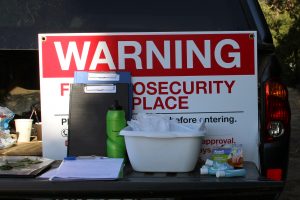
Over the moon: Brothers share their secrets to long-term success
26 August 2021
Spray technology for vegetable growers: a guide to getting it right
31 August 2021One of the best defences against pest and diseases is to implement on-farm hygiene practices, which will limit the entry, spread and establishment of pests and diseases, and help to protect your crops. AUSVEG’s Madeleine Quirk reports.
As international trade and tourism increase, Australia is at greater risk of plant pests coming into the country. But how does this affect vegetable producers?
With increasing globalisation, it will be easier for plant pests to enter and move around Australia more rapidly, potentially affecting vegetable production regions. Farm hygiene is the practice of implementing simple yet effective measures on-farm to reduce the risk of entry, spread and establishment of plant pests on-farm.
Farm hygiene is the first step to helping growers protect their own business and the wider horticulture industry, while minimising production losses and unnecessary costs associated with pest outbreaks.
This article focuses on some common farm hygiene practices relating to farm staff and visitors. Every day, staff, contractors, service providers, suppliers, industry representatives, and in many cases, tourists and school groups, work on or visit vegetable farms.
This can create a significant biosecurity risk, as many organisms can hitchhike on clothing, hands, footwear and vehicles, and they can seriously affect a grower’s bottom line. However, if implemented correctly, farm hygiene practices have the potential to significantly reduce these risks.
Visitor inductions
The first step to limiting the spread of pests and diseases on-farm is to install biosecurity signage at property entrance points. Gate signs should display a contact mobile number in clear, large writing, encouraging visitors to register their presence with the business owner or farm manager prior to entry.
Additional signage directing visitors to a designated parking area may be useful. When a visitor arrives at the designated parking area, further signage should direct them to the farm office to sign-in.
Keeping a visitor register is important for both biosecurity and safety purposes, and should request details including name, phone number, sign-in time, sign-out time, and purpose of visit. Induction of all staff (including casual workers and backpackers), contractors, service providers, and suppliers should be undertaken prior to commencement of any work on-farm.
Induction sessions should outline the following:
- Biosecurity measures to be undertaken on-farm.
- The business’ biosecurity plan.
- Biosecurity checklist.
- Risks posed by exotic and endemic pests to the business.
- Key exotic pests of concern.
An example of a farm biosecurity induction manual can be found online by clicking here.
Biosecurity signage is also available from AUSVEG free-of-charge. Please send an email to science@ausveg.com.au or call 03 9882 0277 to request signs or for further information on developing a biosecurity induction.
Come clean, go clean
Many pests and diseases are spread mechanically by footwear, clothing, gloves, hair, cars, and personal equipment.
To ensure that staff, contractors, service providers and other visitors ‘come clean and go clean’, meaning they are not spreading diseases or insect pests from one farm to another, staff and visitors should have access to the following items and should use them when required:
- Footbaths and scrubbing brushes.
- Disposable booties.
- Disposable overalls.
- Hand sanitiser.
- Clean gloves.
It is very common for contractors, service providers, casual staff, and tourists to visit multiple properties in one day and with that comes a greater risk of spreading pests and diseases from one property to another. Entry on-farm should always be conditional to a biosecurity induction.
Limiting on-farm vehicle movement
Limiting worker, contractor or visitor movement from different areas of the property can reduce the spread of plant pests, both on-farm and between farms.
Separating a farm into different zones will help to limit movement between different areas. A farm can be separated into an exclusion zone, separation zone, and farming zone.
- The exclusion zone restricts nonessential visitors and staff from internal roadways, pathways, and farming areas. Visiting vehicles are to be limited to specific car parks at the farm entrance.
- The separation zone consists of internal roadways and pathways on-farm. Only essential vehicles should have access to these areas.
- The farming zone is considered the area where crops are grown. Only dedicated farm vehicles and machinery should operate in these areas. Zones should be separated by physical barriers such as fencing and signage.
It is also important to ensure that proper sanitation procedures are in place between zones, and only essential vehicles and personnel can access these areas.
On-farm biosecurity can be simple, yet these simple steps can significantly protect your farm business.
For information on other farm hygiene practices, including advice on managing biosecurity risks associated with packaging/pallets/bins, waste and weeds, planting material, and wind, please click here.
Find out more
Any unusual plant pest should be reported immediately to the relevant state or territory agriculture agency through the Exotic Plant Pest Hotline (1800 084 881). For further information, contact AUSVEG on 03 9882 0277 or email science@ausveg.com.au. The Farm Biosecurity Program is funded by the Plant Health Levy.
This article first appeared on page 52 in the autumn 2020 edition of Vegetables Australia. Click here to view the full publication.
Cover image: Biosecurity signage is available from AUSVEG.



